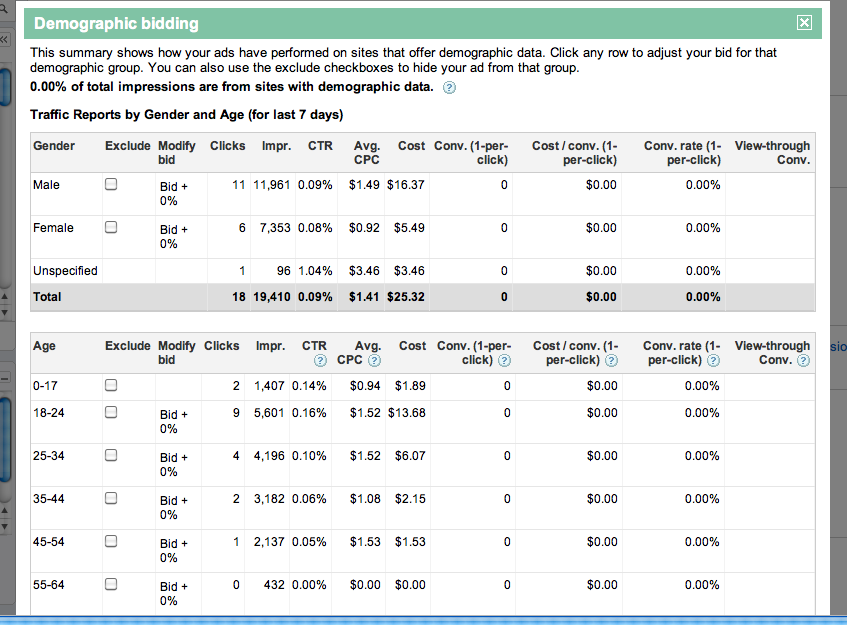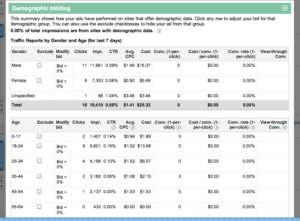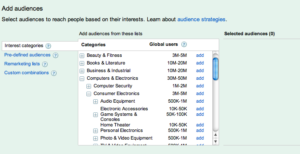We have had Interest Category Marketing, a display network targeting feature that is still in beta, available in some accounts for a while, but this month I began using it and thought I’d share a few of the initial observations I’ve got, as well as the good news and the cautions I’ve found.
First, we should discuss the way Interest Category marketing works. It’s expected that it will be rolled out to all (or at least more) AdWords advertisers in the near future, and having an understanding of how it works and doing some advance planning never hurt. As Google says, they use the content of pages and sites people visit to determine their interests, much as they use the content of pages and sites to match keyword targeted content ad groups to those pages and sites. In combination with information about how frequently users visit these types of sites, they determine the Interest Categories each user falls into. They have also more recently launched the ability to target users within each audience by gender and age demographics as well by using the sites a user visits to infer their gender and age category. This sounds a bit more assumption-based, but overall it is likely worth using if you have a product or service that performs better, or is only targeted for, a specific gender or age group.
I initially set up the Interest Category Marketing campaign with several ad groups segmented in two ways: one, by subject, and two, by ad type- so I had ad groups laid out as such:
Topic A-Text Ad
Topic A- Image Ad
Topic B- Text Ad
Topic B- Image Ad
When we have discussed audience targeting with our Google reps, they’ve recommended initial targeting to audiences only, without keywords, because the idea is that the audience is restricted (specialized) enough that adding keywords would further restrict traffic to the point where the campaign might get very little traffic and not perform usefully. I understand and agree with this in theory, and since I carefully chose the Interest Category audiences to match my topics for each ad group, I initially launched the campaign without keywords, with ads targeted for each ad group’s Interest Category. However, upon further examination of some of the sites our ad groups were showing on, I added keywords to several of the more general to further specialize the traffic they receive, and may add them to the more specialized as well if cost per lead can not be controlled via site exclusion. This way you can leverage both the audience targeting and add additional specialization within the broader categories.
At this point, the level of specialization and ROI I’ve seen with Interest Category Marketing (without keywords) are going to need to improve before I’d be able to run these campaigns more successfully than keyword-based, non-audience-targeted campaigns. That will vary by account type, as the audiences available for Interest Category targeting are more appropriate for some types of products and services than others, and some categories show on sites with much more specialized audiences than others which show on more general sites. This difference is suggested by the levels of user availability listed in the AdWords interface when you are choosing audiences, as the broader category listings inevitably have higher audience counts than the more specific categories they contain within.
I’ll continue running my ad groups, because with further specialization and modification, as well as after gathering data with which I could make exclusions, they are gaining useful conversions and CPL is coming down. I definitely wouldn’t use it as my only display network strategy at this point, but as a supplement to reach additional users I think it’s a useful targeting tool.
Without much more ado, I’ll finish up with my initial observations and advices!
- Wow! They can spend a lot of money. This isn’t a big surprise for the content network, but it’s important to anticipate especially if your budget is small. On the first day I launched it, my first campaign spent its entire $500/day budget in the hours from 3 pm-midnight, and then spent its next day’s $500 from midnight to 8 am. One thing about starting content campaigns: until you have data with which to further specialize/manage and exclude placements, cost per lead can be more inflated than it will be in the long term. You can prevent some of this inflation, of course, by excluding your campaigns from showing on particular types of sites via the Site and Category Exclusion Tool, and by adding as exclusions any sites you expect to be unsuccessful based on previous content campaign experience. But regardless, these can still spend very quickly. I lowered my budgets substantially and am still receiving a good amount of data with which I can optimize, so that is working out better.
- Think carefully not only about what you sell or the services you provide when choosing categories to market to, but also audiences whose members will likely be interested in your product or service outside of your exact offering category. For example, people interested in attending a fashion school might be appropriately targeted via a trade school audience or via a fashion design interest category with appropriate keywords to further specialize if necessary.
- Separate the ad groups you run for image and text ads. This is just a good general piece of advice for all display network ads, but at least in my Interest Category campaign, the difference between the performance of image ad and text ad ad groups is substantial. My image ad groups, which are exact Interest Category target and bid duplicates of my text ad groups, all have CPC substantially under and ad positions higher than their text ad counterparts. I assume it’s because the competition level is lower, but I don’t know for sure. Either way, if you separate the ad groups you can better manage and leverage the lower-cost traffic you receive.
- If you want the best visibility into which URLs each Interest Category is matching you to, at this point you’ll need to put each Interest Category (audience) into its own ad group, because AdWords reporting allows you to see either performance by Interest Category or by URL under the Networks tab, but not by both Interest Category and URL simultaneously. If you separate each category into its own ad group you can have more visibility into which URLs each category matches you to. This is a good idea, I believe, because the category targeting is in almost all cases more general than the URLs my accounts are matched to in my non-audience targeted, keyword-targeted display network campaigns. This isn’t necessarily terrible, as it reaches a wider audience, but visibility is required for proper optimization. Google hopes to complete the Audiences tab to allow fuller visibility in the future, but we’re not there yet.
Overall, it’s an interesting and promising feature that has all of the signs of being very useful in the long term, but as with all display network (and all PPC, I suppose) functions, caution is required to have the best chance of making it work without wasting money and time. Hopefully these advices will help- if you’ve had experience using the feature, please let us know what you think, and any best practices you’ve discovered!






